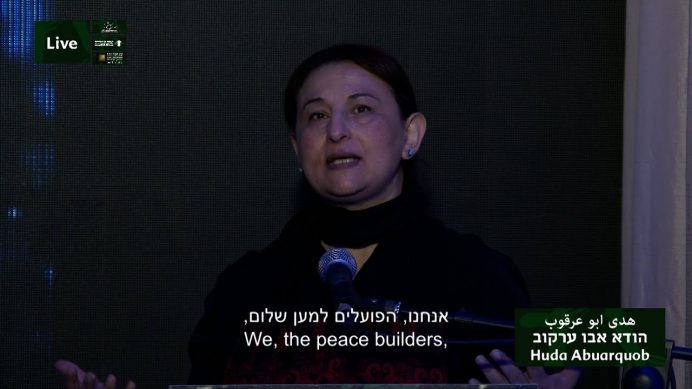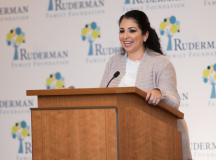Adam Basciano is the co-founder and former director of IPF Atid, Israel Policy Forum’s network of next generation peacebuilders. In this article, he explains how a confluence of trends can guide the next wave of innovative Israeli and Palestinian peacebuilding.
The past two years have seen people and institutions adapt to accommodate new realities brought on by the coronavirus. These shifts occurred across nearly all sectors and ways of life. Within private philanthropy, trends were motivated by the necessity to deliver impact creatively and quickly, as well as a realisation that old ways of doing things were simply not enough. Social change-agents are now continuing to ‘use the current disruption of the status quo as a way to rethink long entrenched systems and practices.’ From global health extending to environmental and social crises, new ideas, rules, and structures are being built to advance more sustainable solutions for the future.
For peacebuilders across Israeli and Palestinian society, these shifts represent a unique opportunity. If leveraged effectively, they can empower organisations to expand capacity, boost funding, and deepen their partnerships with donors. Such long-term planning is also ripe for the current political moment, as new leaders in Washington and Jerusalem create an opening by pivoting away from the Israeli-Palestinian arena for the time being.
Whether from decades-old institutions or newer individuals taking initiative for the future, those working for peace and compromise in the region must use all the tools at their disposal to deepen their impact. Together with the support of partners abroad, these peacebuilders can build robust and interconnected webs of infrastructure to ultimately sway their societies’ moderate majorities in their favour, counter extremists who oppose peace, and build steady momentum towards a two-state framework over the long-term. As we inch forward into a post-pandemic world, the ideas offered in this article reflect emerging trends from within and beyond philanthropy.
THE NEED TO THINK CREATIVELY, AMBITIOUSLY, & STRATEGICALLY
For many of the intractable social and environmental problems we now face, the solutions are not yet known. Existing approaches are proving insufficient, and many funders are exploring how they can intentionally fund social innovation and find new strategies with the potential to create breakthrough change. – Monitor Institute by Deloitte
Funders are increasingly providing unrestricted gifts, as opposed to limited project-based contributions, which are enabling them to more holistically support organisations and their abilities to pilot new ideas. Recognised philanthropist MacKenzie Scott has been at the forefront of this ‘seeding by ceding’ approach, arguing that ‘teams with experience on the front lines of challenges will know best how to put the money to good use.’ While it remains to be seen how much the trend will stick, the approach empowers recipient groups to cover essential overhead costs to keep the lights on and staff their teams, while strategically and more creatively planning for the future.
In a gridlocked issue like the Israeli-Palestinian conflict, investing in this capacity building and innovation is in particular demand. Forward-looking organisations can meet this new development head-on by developing long-term plans for capacity-building, as they work to identify suitable funders willing to engage in such transformational partnerships.
Additionally, the philanthropy world in recent years has internalised the interconnected nature of these complex issues, leading to a new willingness to engage in policy advocacy and systemic change. Israeli and Palestinian peacebuilders can play a critical role at this macro level by representing their communities to government figures and building international awareness of their shared challenges. Newer strategic opportunities in philanthropy and beyond can also be opened up through geopolitical developments, whether looking to areas like climate cooperation or the Abraham Accords (as argued by Koby Huberman in these pages recently).
There is a long list of such forward-looking peacebuilding efforts doing this work on the ground. EcoPeace’s enduring commitment to environmentalism and peacebuilding — in particular their ‘green–blue deal‘ vision for aligning the interests of Israel, Jordan, and the UAE — culminated in an agreement between the three nations at the end of last year. In the business world, Tsofen is guided by an ambitious vision to increase the percentage of Arab citizens employed in Israeli hi-tech to at least 10 per cent by 2025 (a 20x increase since the organisation’s founding in 2008). Looking to American political opportunities in Washington, New Story Leadership lifts up the diverse lived experiences of emerging Israeli and Palestinian leaders by faciliating internships for them in Congressional offices. And using just the power of words and social media from the Gaza Strip, activist and writer Muhammad Shehada reaches thousands of predominantly American Jewish and abroad readers through his column in the Forward.
As donors expand their horizons for impact, peacebuilders can learn from these innovative examples. Additional actionable ideas and insights gleaned from the field include:
- Testing new ideas, and allocating budget lines if possible, for programs and outreach that can engage untapped audiences, communities, and future partners.
- Utilising new online tools and social media channels that can deepen outreach, community-building, and expertise.
- Pursuing and advocating for multi-year, unrestricted grants from funders.
- Empowering underrepresented and underserved stakeholders, who can provide helpful feedback for what is most needed for them and their communities.
- Inviting and internalising feedback from program participants by hosting focus groups and other similar mechanisms.
- Incentivising creativity by fostering spaces for open brainstorms, including through innovation task forces to build alignment and problem identification.
- Embracing how to ‘fail well‘.
- Growing public profiles by writing op-eds, speaking in conferences, and being active in online thought leadership.
- Educating government officials (within appropriate means) on the many local challenges communities face across peacebuilding efforts.
THE OPPORTUNITY TO EMPOWER YOUNG PEOPLE
The retirement of the baby boomer generation will precipitate the largest generational shift in leadership the world has ever seen. Fostering the next group of global leaders to shape a more free, prosperous, and just world is one of the defining challenges of our time. The unprecedented events of 2020 highlight that the next generation of global leaders must be equipped with the skills and values to lead, manage, and solve complex challenges in uncertain times. — The Atlantic Council
It is no secret that millennials and Generation Z (and likely those next in line) are increasingly championing social causes in their social media feeds, volunteerism, and careers. Some believe that ‘Generation Impact,’ as Sharna Goldseker and Michael Moody refer to younger donors in their book of the same title, is revolutionising the social sector and ushering in a ‘golden age of giving.’ In the workforce, they are also distinctly entrepreneurial. A Global Entrepreneur Report by BNP Paribas even characterised these innovators as ‘millennipreneurs‘—a category of young business owners with distinct ‘hopes, dreams, targets and influences.’
While the strategies and tactics required to leverage this trend will vary by society, engaging younger generations today will see these committed change-agents grow into valuable force multipliers, innovative staff members, future donors, and vital network assets over time.
Additionally, large segments of wealth (estimated at $59 trillion) are set to shift down to younger generational stewards over the next 50 years. These younger generations see and understand the world differently than their predecessors, with philanthropists being no exception. They gravitate towards innovation, newer media approaches, and brands that resonate with their values. Organisations that are more forward-looking and youth-driven, therefore, will be in better positions to benefit from this generational inheritance transfer.
From volunteers to professional staff and board members, involving young people can take a myriad of forms. In just over the past year alone, Embodying Peace has helped connect young volunteers log over 4,000 hours with on-the-ground NGOs through virtual internships. These internships provide meaningful experiences for the students contributing efforts from abroad, in addition to delivering value for the partner groups on the ground. The new Heart of a Nation network (which I’m involved with) recently announced plans for a teen essay competition from young American, Israeli, and Palestinian teenagers. This effort will not only spotlight young activists across the English, Hebrew, and Arabic languages, but it also promises to inspire entire communities through their optimistic visions of peace and advancement.
The Palestinian Internship Program, another effort fostering professional skills and relationships, develops the Palestinian tech sector and integrates younger generations into the industry, including with large multi-national companies such as Google and Intel. These young program alumni go on to generate an ever larger impact as they further develop in their careers and interact with their professional networks. The data also confirms the underlying conflict resolution theories behind PIP’s work, as these young participants report being more receptive to cross-border work and open to engaging with Israelis following their experiences in the program.
As more young people become engaged, continue expanding their networks, and building new companies and ventures, peacebuilders can find ways to integrate and engage them through ideas including:
- Cultivating engagement by intentionally ‘inviting in’ and providing structure for younger generations to support and lead real peacebuilding efforts.
- Targeting younger demographics using tailored messaging, accessible programming, and partnerships.
- Empowering younger professional staff members with greater responsibilities and support to pilot new ideas.
- Adding young leaders to organisational boards and decision-making committees.
- Building professional work environments to be meaningful and attractive for young employees, in order to best retain them.
- Providing leadership development opportunities to further support young professionals and their growth as contributing members of teams.
- Educating younger age groups on past histories and success stories from the peace process.
COMING TOGETHER & OPERATING IN NETWORKS
As philanthropy continues to mature, becoming less an archipelago of disassociated foundations and more a cohesive profession, it needs its supporting organisations to partner strategically and systematically to stitch our field together. — Council on Foundations
Operating through networked relationships, structures, and alliances is the new norm. With our collective shift to hyperconnectivity — leading some to dub The ‘Networked Economy’ as the next economic revolution — businesses in particular have leveraged networks to drive innovation and build more valuable relationships with their stakeholders. In addition to collaborating with other peer foundations, funders are also flexing their convening powers with the hopes of spurring creative and ambitious partnerships through their webs of grantees. Whether online, in-person, or beyond borders, the more networked an organisation is, the greater their impact and capacity can become. ‘With patience, honest communication, adaptability, and alignment on a common vision,’ write two philanthropy executives in Philanthropy News Digest, ‘nonprofits and foundations can build lasting relationships to make an impact.’
In Israeli and Palestinian peacebuilding, the formidable and complex nature of the challenges at-hand means groups must pursue such strategic collaboration. Socio-political environments, to be sure, may challenge these efforts and require them to take different forms. Yet the opportunities are too great to pass up. Newer technologies provide endless capabilities for transcending physical borders and barriers. The flow of communications and professional knowhow has been made more seamless through cloud document sharing and other software, enabling groups to share best practices more freely than ever before. Within the workplace following the pandemic, organisations are increasingly empowered to pursue more creative layouts and practices, including in partnership with others to pool resources and minimise infrastructure distress.
The Alliance for Middle East Peace (ALLMEP) is a prime example of an institution harnessing collaboration and the power of networks amongst its over 150 member organisations. By the beginning of this February, already forty of those groups participated in their 2022 ‘Innovation, Scaling, and Partnership’ workshops, which fostered partnerships and taught best practices in applying for US federal government grants. As a diverse collection of groups with many overlapping mandates, some in ALLMEP’s network have even gone on to form their own smaller coalitions. Budo for Peace launched ‘One Team – Sports for Social Change’ last year to unite groups and young people in the region who are working toward social justice through sports. By leveraging the knowledge and data of its thirteen sports organisations, Sports for Social Change is able to fill in important gaps in the landscape, such as through mapping out areas in need of youth bridge-building through sports programming.
All individuals and groups operate within systems, whether realised or not. Forging ahead in establishing and harnessing networks can be achieved by:
- Building out individual and organisational networks that leverage geographies, audiences, interests, and other overlapping areas of value.
- Identifying areas of need and potential ways to fill gaps in skills from multiple stakeholders, including through pro-bono services from corporate funders and partners.
- Seeking guidance from donors vis-a-vis potential partnerships and overlapping network activities.
- Dedicating professional staff and resources to focus on partnerships.
- Diversifying revenue streams from private and public sources.
- Considering how digital tools and social media can be used to join, build, and scale valuable networks.
- Joining official coalitions and alliances.
OVERCOMING OBSTACLES BY PLANNING FOR THE LONG-TERM
Philanthropic futurism in its simplest definition is seeing and understanding future trends and technology and then understanding and articulating how they can be applied today to solve and support the finding of historical, current, and future societal problems’ – ‘Future Philanthropy‘ by Ryan Ginard
Absorbing these trends, peacebuilders should feel empowered to stake their flags deeper and more permanently into the sand. By stretching one’s perspective out years and decades — either with funding partners or just for the hypothetical exercise in planning — one can see how creative ideas, empowered young people, and networked efforts can combine to create new paradigms and realities for peace. Addressing and working to overturn such upstream causes of instability, division, and oppression is fundamental to creating the structural change that millions of Palestinians and Israelis need.
In building up this permanent infrastructure, such visionary investments for peace can serve to combat the many negative forces working against compromise. Twenty-five years after the Oslo Accords were signed, chairperson of Israel Policy Forum Susie Gelman reflected in Haaretz that the peace movement’s rejectionists ultimately succeeded in opposing the two-state solution because of their sustained, decades-long commitment to the effort. She wrote in 2018, ‘if believers in two states can draw any lessons from this, we must recognise the importance of settling in for the long haul.’
One new organisational effort underway that is primarily addressing capacity-building challenges over the long-term horizon is Amal-Tikva. Through their own workshops and reports, they are helping peacebuilding groups across key areas like measurements and evaluations, organisational storytelling, and strategic planning. Once momentum can take hold and groups progressively add new capabilities under their belts, the entire Israeli-Palestinian peacebuilding sector can begin running faster than ever before over the years to come. Peacebuilders can piece together long-term strategies by pursuing tactics like:
- Training and positioning staff, volunteers, and other supporters for success over a long-term perspective.
- Identifying and maximising investments in individuals and the organisation’s future, while separating out costs that will never be recuperated.
- Investing time and energy in retaining program participants as lifelong alumni.
- Mapping out systems of power and behaviour to identify key leverage points and areas for long-term disruption.
- Creating strategic yet flexible multi-year roadmaps.
- Asking yourself: ‘What world do we want to craft and be a part of 10-20 years from now?’
CONCLUDING THOUGHTS: MEPPA’S ‘BIG BANG’ MOMENT
Yet while we don’t know exactly how philanthropy will change over the next decade, we do know the general directions we should be looking in to spot the emerging seeds of what’s next … Funders that aren’t able to change and evolve to match the shifting realities of public problem solving may, at best, be leaving potential impact on the table, and at worst, be at risk of losing relevance and influence. — Monitor Institute by Deloitte
After many years of relative stagnation in the peace process, bright lights are emerging on the horizon. Positive trends and developments are converging to provide direction and a spark for peacebuilders on both sides of the Green Line.
One major potential disruptor, in addition to the Abraham Accords, is the new Nita Lowey Middle East Partnership for Peace Act (MEPPA). Passed in Congress in 2020 after years of advocacy by ALLMEP and others, MEPPA opens up $250 million in new peacebuilding and economic development support from the U.S. government. Just last month, MEPPA announced its first awards in the region: one grant will train and empower businesswomen, and the second will support Palestinian and Israeli trade associations to ‘leverage their business networks and extended connections across Israel and the West Bank.’
Civil society leaders are now calling on other foreign governments in Europe to join the MEPPA funding effort. In the U.K, the Labour Party and Liberal Democrats have joined the government in each officially endorsing the concept of an international fund.
As argued here, private philanthropy has a crucial role to play in maximising this ‘big bang’ moment for the field. This notably includes helping boost capacity from organisations who otherwise might struggle with the application procedures and implementation requirements from Washington.
Most big challenges indeed are insurmountable in the short-term. Peace in the Middle East is no exception. Yet anything is possible over the long-term. Without a doubt, peacebuilders must operate in the present moment and problem-solve amongst the many obstacles they face from all directions. Those with the ability and foresight to ride these big waves into the future, however, will continue finding new waters to explore, willing partners to engage, and outsized impact to permanently change the landscape for the better.





































